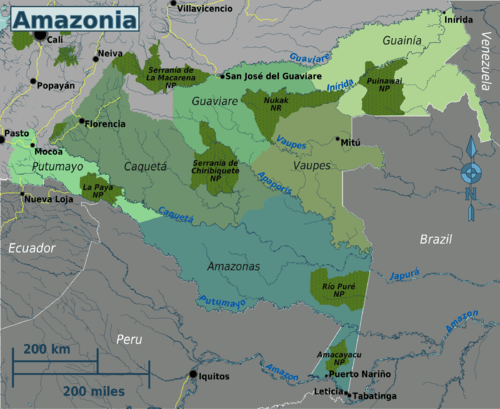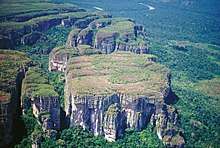Amazonia (Colombia)
Amazonia is the southernmost region of Colombia, blanketed by the green sea of trees spanning over 400,000 square kilometers—well more than a third of the country. The impenetrable jungle provides for Colombia's most remote and least populous departments, home to an incredible diversity of flora and fauna, natural beauty seldom touched by mankind, rivers shared by fantastical pink dolphins and horrific river monsters alike, and unique human cultures that have barely had contact with the outside world.
Regions

| Amazonas (Colombia) The country's southernmost department is by far its most visited Amazon territory, with all the action concentrated along the Amazon River itself, at the very southern tip. |
| Caquetá |
| Guainía |
| Guaviare Guaviare is one of Colombia's most unstable regions, at least in the inhabited parts, and travelers really should avoid non-essential travel here. |
| Putumayo There is substantial guerrilla activity and smuggling along the border. Use caution when visiting this region and check the current situation ahead of time. |
| Vaupés |
Cities
Amazonas department
- 🌍 Leticia is the main Colombian port on the Amazon river bordering the Brazilian port of Tabatinga. No road leads to that common urban area and it can be reached only by boat or by plane from both countries.
- 🌍 Puerto Narino is a quiet village upriver from Leticia with very eco-conscious inhabitants.
- Puerto Santander
Caquetá department
- Florencia
- Inírida
- 🌍 San Vicente del Caguán
Putumayo department
Guaviare department
- San José del Guaviare
Other destinations
Understand
Talk
The number of indigenous languages here is pretty staggering—a good 60 or so. Ticuna is the language you are most likely to encounter, as it is spoken by some 40,000 people in the Tres Fronteras region around Leticia. It is more frequently heard the further you get into the jungle, naturally, and it is quite possible to run into older people in more remote areas who speak limited Spanish. Spanish will always work, though, unless you have somehow gotten to some extraordinarily remote area, which usually means that you are traveling with a guide anyway. Ticuna is not related to any other language.
Beyond Ticuna, you are looking at very obscure languages with no practical travel application outside a few villages that you probably won't be able to reach anyway without a guide. For the linguistically very curious, though, the second most spoken languages (by around 4,000 people each) are Tucano and Cubeo, both Tucanoan languages, and found in Vaupés along the Vaupés River and its tributaries. Locals there tend to be local polyglots, speaking several indigenous languages, so you should be able to try out one if you somehow manage to get there!
Get in
By plane
For most of the region, flying is the only viable option of arrival, as most destinations are not connected by road to... anywhere. For the most popular tourist destination of Leticia, there are direct flights from Bogotá through LATAM Airlines and Copa Airlines. Satena Airlines also offers flights there, but the extremely wacky three-leg route through the unknown lands of Araracuara and La Chorrera makes this a terrible option unless you are visiting those areas as well.
For the rest of the region, Satena Airlines is the only option, with flights to all of the department capitals, as well as some more obscure/remote Amazonian towns. Most of these routes have infrequent service, with all to frequent multi-day delays and generally weird experiences. That is to say, if you are trying to fly to some crazy place like Mitú or Inírida, consider it a bold trip and include extra days in your schedule for flight disruptions. Amazonian weather does not help. Note that it's usually necessary to go through Satena's Spanish website, as for unknown reasons many flights are not displayed on the English language site.
By land
Overland transport is not a good option for visiting the Colombian Amazon. It is possible to reach western Putumayo and Caquetá by bus, and possibly San José del Guaviare, but these are very dangerous destinations both along the route and at the endpoint, and should be excluded from any independent travel itinerary. The rest of the region is not connected to northern Colombia by road.
By riverboat
Rivers are the real Amazonian highways, and it is very much possible to travel down the Putumayo or Guaviare Rivers, but not safe due to rebel/terrorist activity. If you are going to Leticia, you will likely find more foreign visitors arriving by boat from Iquitos, Peru than by plane from Bogotá! This is obviously a fun option too, since you'll get to explore the Amazon along the way. As Leticia is right at the center of Tres Fronteras, the region where Peru, Colombia, and Brazil intersect, and is thus a hub for international travel in the Amazon. Border crossings and at-border visas are easy, and tourists there often "border hop" just to collect passport stamps.
Get around
See

Do
While short on movie theaters and golf courses, the Colombian Amazon has its fair share of possibilities for outdoor activities. Fishing is likely the regions favorite sport (but followed closely, of course, by football), with piranha fishing being especially popular with the visitors. Boating the rivers provides incredible opportunities for wildlife spotting: river dolphins, tapirs, caymans, golden eagles—with the immense biodiversity of the rainforest, you will hardly scratch the surface. It is quite worthwhile to do some trekking in the jungle as well. Although trekking is not as great for wildlife spotting, a good guide will help you identify the interesting flora and sounds of the jungle, and may be able to take you to a local village or a maloca. Swimming in the jungle is also a lot of good fun, although fears of the legendary candirú, caymans, snakes, piranhas, etc. do often dissuade the weak-kneed.
Eat
Most of the Colombian Amazon (including Leticia!) is so remote and isolated that food will have to be local, and thus having fewer and more expensive vegetables, less meat, and far less dairy. On the upside, this means that you will be eating lots of fresh food, like fish and fruit, and on the downside, you might wind up eating a certain amount of canned food as well. For fish, look out for local favorites like pirarucú and dorado. The former is leaner but delicious and the latter very fatty and rich. Piranha is another common local food, since the Amazon is really full of them. While too small to make for an easy meal, piranha meat is actually quite tasty.
Drink
It's very hard to find (it's a little more common in the Peruvian Amazon), but drink aficionados should seek out chuchuhuasa, a spirit made from the bark of the eponymous plant mixed with aguardiente. Tasting much like a sweeter version of bourbon, the drink is more popular with locals inside the jungle, rather than in the towns, where it is generally not commercially available. It's actually pretty great for a jungle trek, as the plant contains a strong stimulant (and, reputedly, aphrodisiac) effect, in addition to conditional medicinal benefits, treating ailments such as diarrhea, arthritis, menstrual irregularities, and upset stomach.
Yagé (pronounced yah-HEY, with a very soft h) is a drink, known better in other countries as ayahuasca, uniting virtually all the multitudinous and disparate indigenous cultures of Amazonia. A strong hallucinogen, its primary use is religious, for divination and healing. As it is potentially harmful, it should only be drank under the guidance of a shaman, who will both monitor your health, help you "see" more, and chant in the dark for hours on end. On the first use, yagé is likely to induce pretty serious vomiting and diarrhea. If you are very interested in the drink, culture, and tradition it may be worthwhile to schedule two nights in a row with a shaman, which will really boost your chances of experiencing something more interesting.
Stay safe
You might assume that the remote jungle lands of Colombia might be the refuge of the FARC, but the fact is that much of it is too remote for even guerrillas to operate. The extreme south is very safe (aside from natural dangers like snakes and insects!), and visitors should not worry about violence on a trip to Leticia. The area around Leticia, in particular, would be an impossible target for militants even if they were interested in traveling so far south—the Colombian military presence in its tri-border region with Peru and Brazil is immense. Western Putumayo and Caquetá, as well as northern Guaviare, however are real hotbeds of guerrilla activity and should be left off all itineraries. The conflict may impact trips to other remote capitals, but the extreme problems of mass assaults on towns and frequent hostage-takings seem to have died down in the last ten years.
Travel to Amazonas department carries risks: there are a lot of diseases, especially those transmitted by mosquito bites. Take the necessary medical measures before travelling, get shots against the probable diseases you may encounter, and carry mosquito repellent.
Go next
The Colombian Amazon is pretty remote. While bordering Pacifica and Orinoquía to the north, travelers are far more likely to be visiting the southern tip, which is cut off from the rest of the country, and more connected with adjacent towns and regions of Peru and Brazil.